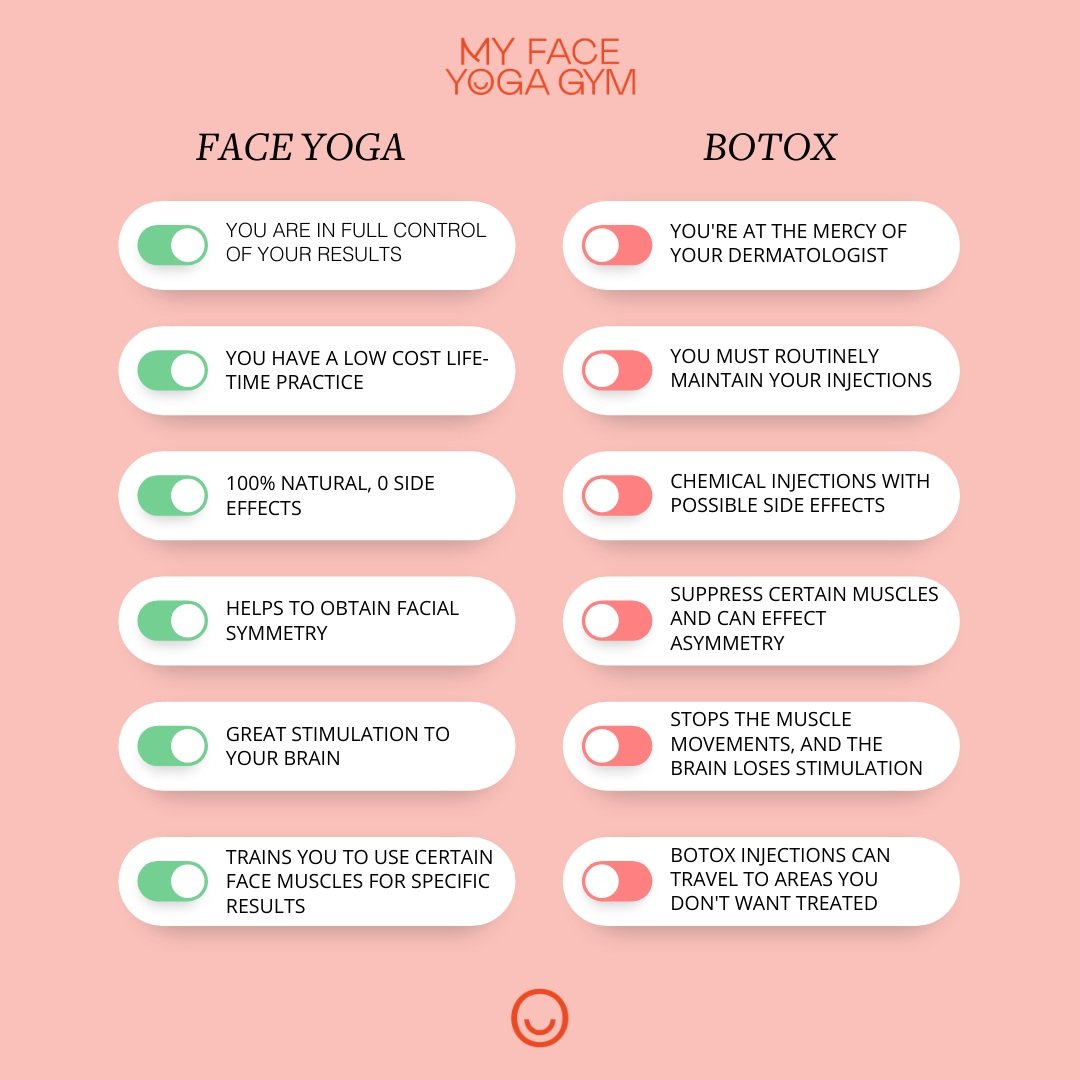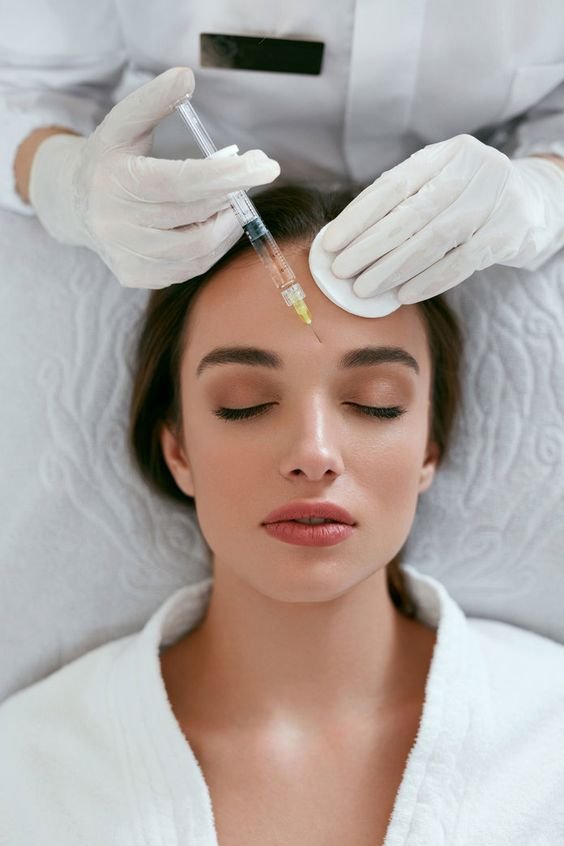Botox and Face Yoga - Everything You Need To Know
What is Botox?
Botox is an injectable medication made from botulinum toxin. This is a chemical produced by a bacteria called Clostridium botulinum.
In most cases, people receive Botox Cosmetic as an FDA-approved treatment for wrinkles. But there’s also a medical version of Botox that can treat a variety of health conditions, like migraine, overactive bladder, and excessive sweating. It is in most cases a relatively safe way to deal with health conditions and cosmetic producers. But through this article, we want to look at what Botox is, and the long-term effects it can produce on your face.
Although Botox injections are generally considered safe. They do come with a black box warning, it’s important to know what you are getting, and risking, when making your Botox appointment. And if the procedure will give you the desired result long term.
What are the kinds of injectables you can get on your skin?
Botox
Dermal fillers
Hyaluronic acid Restylane, Refyne, Defyne, Juvederm, Vollure, Volbella, and Belotero.
Belafill, and silicone.
Kybella is a deoxycholic acid that dissolves small quantities of fat. It's currently approved for use beneath your chin.
Xeomin
It’s worthwhile to note that new products and injectables are constantly developed for the growing market.
What does Botox do to the muscles?
Botox injections block certain chemical signals from nerves, mostly signals that cause muscles to contract. The most common use of these injections is to temporarily relax the facial muscles that cause wrinkles in the forehead and around the eyes.
What happens to Botox over time?
“Our bodies dissolve the material by their metabolism, so the more you move the region that was injected, the faster it goes away," explains Golueke. This is why your lips—which are constantly in motion—need more frequent touch-ups than the rest of your face.
Botox will wear off as the body regrow new nerve endings to the area where the botulinum toxin has blocked the signal from the nerves, coming to the muscle.
What are the negative effects of Botox?
Injection site reactions
Pain, bruising, and skin color changes around the injection site are the most common side effects of Botox Cosmetic. These reactions usually happen if a blood vessel was temporarily injured by the injection. Injection site reactions tend to show up shortly after your treatment and should go away on their own.
Local bacterial infection is a less common injection-related side effect. When the needle breaks the skin and goes into your muscle, bacteria can get in. The best way to prevent this is to make sure the injection area is clean before each dose. The person administering your Botox injections should take care of this as part of their routine prep work.
Headaches
Headaches are another common Botox Cosmetic side effect. This may be because the medication can cause your muscles to spasm before they’re paralyzed, but it isn’t fully clear what causes it. The good news is that headaches are not usually serious and clear up after a few days.
Over-the-counter medications like naproxen (Aleve) or ibuprofen (Advil, Motrin) can help ease headaches if they’re bothersome.
Forehead side effects
Using Botox on the forehead can lead to unique side effects.
A droopy eyelid — called blepharoptosis — is one common side effect. It’s reported to affect up to 20% of people who receive Botox Cosmetic treatments on the forehead. A droopy eyebrow, known as brow ptosis, is also possible. Both of these effects are usually seen on only one eye, and they should return to normal within 3 to 6 weeks. However, it may take up to 3 months.
The “Mephisto sign” is another forehead side effect of Botox Cosmetic. It can cause the end of your eyebrow to be slightly higher than the eyebrow itself. This makes the user appear surprised or sceptical. The effect is also temporary, but it may last for up to 3 months.
Forehead Botox treatments can also exaggerate wrinkles. This happens when a strong border is created between a paralyzed muscle and a non-paralyzed muscle in the forehead. Again, this effect is temporary.
Particular areas of the face can be more prone to unwanted side effects from Botox, such as the forehead. When receiving multiple injections of Botox onto the forehead, over time the user can experience a slower progression of their muscle training and use because of the toxin and the damage to the nerves.
After long-term Botox use in this area, two main issues form, regular headaches appear when commencing face yoga on the forehead and it can be harder to make a connection with the muscles in this area, so even when swapping Botox for Face Yoga, sometimes the damage is deeply done.
This damage can be reversed, but the person undergoing this process has to be very patient with themselves and take it slowly. The headaches combined with the loss of connection to this area can make it an infuriating and difficult process. Once this has been overcome and they can work gently through this, the brain-muscle connection will be re-established.
Dry skin
Dry and flaky skin can happen to some people around the areas of their Botox Cosmetic injections. Although the cause isn’t completely clear, this appears to happen because Botox lowers the body’s ability to make sweat this can make the skin drier and flakier, and feel tighter.
Spreading of Botox toxin
Although rare, Botox can spread beyond the areas where it’s injected and cause serious problems. This risk goes up if Botox is injected into areas of your body that aren’t recommended or FDA-approved.
Depending on where Botox travels in your body, the toxin in it can spread and cause symptoms like muscle weakness or breathing troubles. These effects can vary in severity and appear hours to weeks after the injections are administered. Developing botulism, an uncommon but serious health condition is also possible.
Difficulty swallowing or breathing
Botox can weaken the muscles that help control swallowing and breathing in the mouth, throat, and neck. This can be dangerous for people who already have problems with swallowing or breathing.
Although these symptoms are uncommon, they can also appear hours to weeks after a Botox treatment session. If you notice difficulty swallowing or breathing after receiving an injection, go to the nearest emergency room as soon as you can.
Eye and vision problems
Botox cosmetics can affect the muscles that control your eyelids, so you might blink less after your injections. This can result in problems such as dry eye, eye irritation, or eye damage. Chronically dry eyes can lead to a scratched cornea.
Botox can also affect the muscles that control eye movements and cause you to experience problems like double vision or difficulty judging distance.
To prevent these problems from becoming serious, reach out to an eye specialist if symptoms like these start to appear.
Nerve or muscle problems
Because Botox injections can cause muscle weakness, people who already have nerve or muscle-related problems — such as myasthenia gravis — should be careful. Botox could make your condition worse.
Do Botox injections carry long-term risks?
Botox cosmetic side effects are usually temporary. But in rare cases, people who receive frequent Botox cosmetic injections over a long period can have permanent changes to the face. These can include changes in a person's facial expressions or being unable to make certain facial movements.
To prevent serious Botox risks, make sure to go to a healthcare provider and clinic that’s trained and licensed to give these injections. Misuse or incorrect use may result in botulism, which can be life-threatening. Contaminated or counterfeit Botox products can also lead to poor results. You’re more likely to run into these issues if you go to a clinic or med spa that’s unlicensed or not properly trained.
What happens with Botox and Face Yoga?
Not only can you do Face Yoga if you’ve had Botox, but you’re also not alone! Every day, women (and men!) just like you are making the switch to more natural face habits and using Face Yoga to transition out of Botox completely. Or they are choosing to lessen their Botox use by working in more face yoga between the injections to give their facial muscles a break and lessen the chance of side effects.
Botox injections paralyze the muscle inhibiting it from moving. And while this may smoothen wrinkles temporarily, we cannot stress enough that a muscle that isn’t used, will lose volume, and its shape and will eventually sag! If you’re ready to make the switch and learn how to actively relax and isolate your muscles, it’s best to wait sometime after your last injection before you start Face Yoga. Depending on how much Botox was injected and into which muscle, will determine when you can transition into Face Yoga. It’s best to ask the person who gave you the injection how long to wait as they’ll know when the muscle paralysis will start to wear off, enabling you the right timing to transition into Face Yoga. That being said, you need to wait for at least four to six weeks after your botox injection before starting the exercise. However, do talk to your doctor first and make sure to get a green light for facial exercise.
Most of the time, you’ll have to wait 6 weeks after the botox injection before starting with facial exercises or facial massage. You don’t have to wait until the injection has cleared completely, as Face Yoga activates blood circulation, and the lymphatic system and helps detoxify, which can help eliminate Botox faster.
To transition from Botox and adopt this naturally proven blueprint instead, simply start with the My Face Yoga Gym routine; ‘My Morning Routine Part One’. This would be a good soft workout post Botox use. It’s reclined and gently works on waking up and balancing the muscles of the upper face, forehead and brows.
Keep in mind that facial exercises can make botox injections wear off a bit faster. You’ll also have some difficulty activating the muscles from the start since botox paralyzes the tissue around the wrinkles.
What other injectables have an effect on Face Yoga that you need to be aware of?
Face Yoga and Fillers
With fillers the story is a bit different – it depends on where they are. If you just had fillers in your lips, you can exercise the rest of the face. Avoid massaging your lips after having fillers to prevent them from moving around and altering your desired look.
If you have had cheek fillers, you’ll probably want to avoid doing cheek exercises for a while. Since the filler can move around before it completely settles.
However, don’t eliminate face exercises because of that fear. You want to keep your cheek muscles strong since they contribute to the overall look of the face.
Just to be on the safe side, do wait a couple of weeks and consult your doctor before proceeding with face yoga.
Why choose face yoga over botox?
The freezing of the muscle may have temporary effects, but in the long run, botox creates more wrinkles because it weakens the muscles. Botox paralyzes the facial muscles and those areas affected by injections can get loose and saggy. In some cases, this can even result in losing speech articulation.
Face Yoga is a lifestyle that inspires a face—body—skin care connection and helps you embrace your age and your lifestyle with awareness and self-love. And the best part is, it only takes a few minutes per day! The Practices we teach are designed to create lasting positive Routines and teach you to love and care for yourself and your skin from the inside out!
Join us now with 60% off memberships. Unlock over 150+ face yoga workouts, programs, face cupping and gua sha videos. Sign up now and save.
6 Months membership for only $39.98
(normal price is $119.94)
12 Months membership for only $79.96
(normal price is $239.88)






